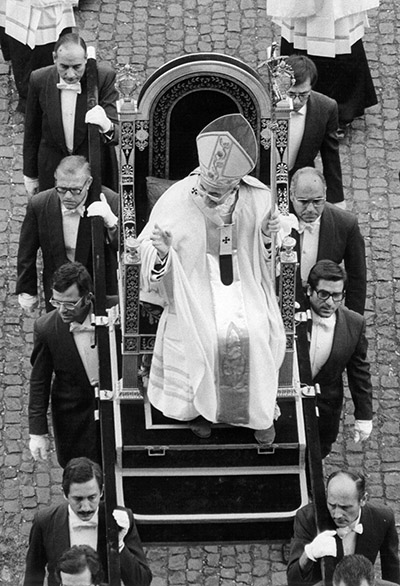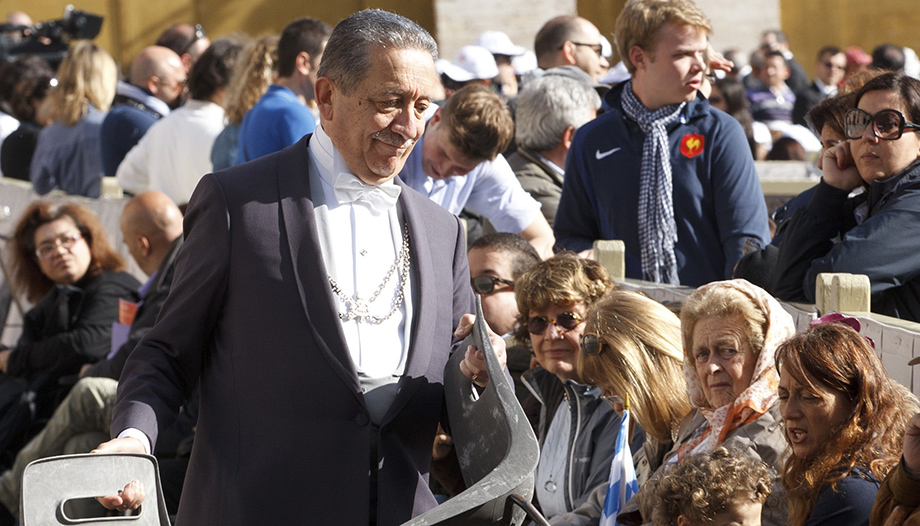









Throughout the centuries they have seen wars, invasions, plundering, exile and a thousand vicissitudes, but always at the service of the Pope: they are the 'Sediari', a lay institution that comes from the Pontifical Palaphrenes and that today are part of what is called the "Pontifical Family".
From the 'Palafrenieri Pontifici' to the 'Sediari'.
The 'Palafrenieri Pontifici' date back to the 10th century. They were in charge of the Pope's escort, accompanying the Holy Father as he rode in a sumptuous procession to take possession of his chair in St. John Lateran (today's Cathedral of Rome), when he left for a public ceremony, or simply when he moved from one place to another. Their name "Palafreneros" comes from the fact that they accompanied His Holiness taking the reins and bridle of the horse that the pontiff rode.
Historical documents indicate that the Archconfraternity of the Pontifical Palafrenieri used to meet in a chapel in the Basilica of St. Peter. In 1565 Pope Pius IV authorized the construction of a church for them: Sant'Anna dei Palafrenieri, today accessible to the public within the walls of the Vatican City-State. The church with its elliptical plan was commissioned to the architect Giacomo Barozzi, known as "il Vignola".
In 1507 Pope Julius II instituted the "Noble College of the Pontifical Palafreneri", confirmed on April 15, 1517 by Pope Leo X, which already included the Pontifical Seditionaries, with whom they also shared the motto.


In fact, the Sediarios -another body made up of gentlemen- became more and more related to the Palafreneros once the Pontiff began to use the gestatorial chair, which was carried on the shoulders of several men. So much so that in 1565 both institutions were officially in charge of the transfer of the Pontiff.
After the Lateran Pacts of 1929, the so-called 'Concordat' between the Church and the Italian State, and in view of the disuse of horses, the Palafreri gathered definitively in the Sediari and the seat of their Archconfraternity left the Vatican walls and moved to the Church of "Santa Caterina della Rotta", a stone's throw away from Palazzo Farnese.
It is not necessary to go too far back in time to remember that the Seditaries used to carry the chair that carried the Holy Father to audiences or events. A custom that ended in 1978, when St. John Paul II did not want to use it, not even for the inauguration ceremony, and has since fallen into disuse.
Newspapers today
Augusto Pellegrini, Gentleman of His Holiness and former dean of the Sala of the Pontifical Antechamber, specifies for Omnes that "the Sediarios have a dean, but he is not called 'dean of the Sediarios' but rather Dean of the Sala of the Pontifical Antechamber.
Today the 'sediarios de numero' are four people, who help the Dean of the Pontifical Antechamber Hall - currently Roberto Stefanori - to receive those who visit the Holy Father during the week in the meetings that usually take place in the Library of the Apostolic Palace".
"In addition to them," adds Pellegrini, "there are the 'sediarios de sobrenúmero', who are summoned by the Dean when a greater participation of them is necessary. (For example, during Wednesday hearings).
Without the presence of horses or saddles, the sediarios continue, today, with their work in step with the times. Presided over by the Prefect of the Pontifical Household, they are persons of trust of the Pope, active in the Vatican to assist the Holy Father in audiences and whom the Pontifical Yearbook includes as the lay part of the pontifical family.












